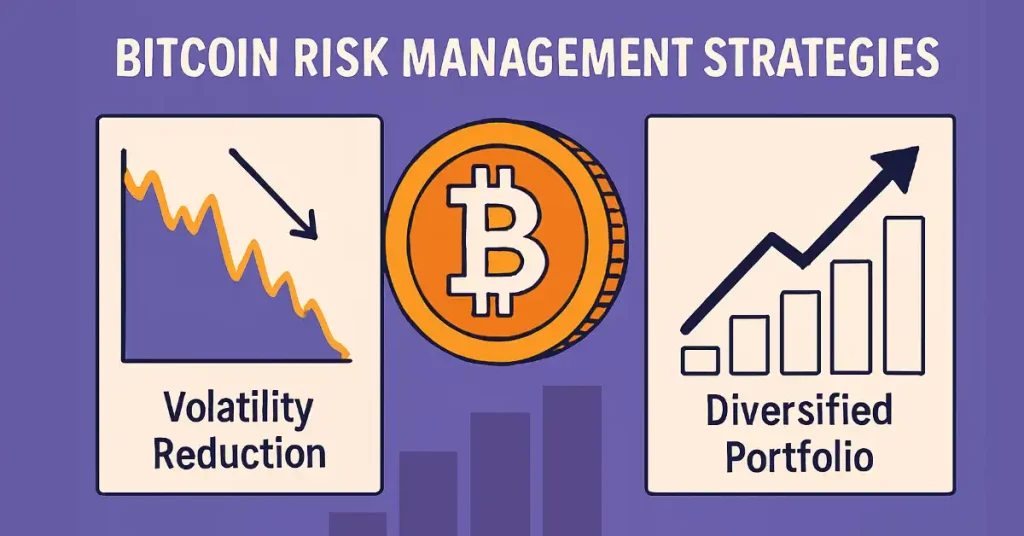Bitcoin, the world’s first decentralized cryptocurrency, has become a popular investment option for many individuals. While investing in Bitcoin can be lucrative, it is not without risks. It is important to have a risk management plan in place to minimize potential losses. In this article, we will explore some effective risk management strategies for investing in Bitcoin. If you’re unsure where to do it, you can visit http://bitcode-ai.live.
As we approach the end of 2025, Bitcoin’s landscape has evolved significantly since this article’s original publication in 2023. The 2024 halving reduced mining rewards to 3.125 BTC, leading to a more modest price appreciation of about 31% by mid-2025, with Bitcoin trading around $93,000-$95,000 as of December 2025—down from a peak of $109,000 earlier in the year. Institutional adoption has surged, with the market cap reaching $1.65 trillion, but volatility remains a factor, at 50–60%, though lower than in 2023. New regulations like the US GENIUS Act and the EU’s MiCA add layers of compliance, while risks from AI scams and geopolitical tensions persist. These updates enhance the strategies below, making them more relevant for today’s investors.
Understanding the Risks of Bitcoin Investing
Before studying risk management strategies, it is important to understand the potential risks associated with Bitcoin investing. Bitcoin is a highly volatile asset, with prices fluctuating rapidly and unpredictably. Additionally, the cryptocurrency market is largely unregulated, making it vulnerable to fraud and scams. Finally, Bitcoin is a digital asset, which means that it is susceptible to hacking and other forms of cyberattacks.
In 2025, these risks have intensified in some areas while maturing in others. Volatility has decreased compared to 2023 levels—Bitcoin’s 60-day annualized volatility dropped to as low as 28.53% in July 2025, making it less volatile than 33 S&P 500 stocks. However, events like the 2025 liquidity squeezes and institutional sell-offs have caused sharp drops, such as the 10% dip in August.
Regulatory risks are now prominent: The CFTC’s approval of spot crypto products in December 2025 brings oversight but also potential bans on high-risk activities. Scams have evolved with AI, including deepfake phishing targeting wallets. Cybersecurity threats remain, with over $2 billion in hacks reported in 2025 alone. Geopolitical factors, like US-China trade tensions, add unpredictability. Understanding these helps tailor strategies to current conditions.
To quantify risks, consider historical data:
| Year | Average Volatility (%) | Major Events | Price Range (USD) |
|---|---|---|---|
| 2023 | 70-80 | Bear market recovery | 15,000-42,000 |
| 2024 | 60-70 | Post-halving surge | 42,000-109,000 |
| 2025 | 50-60 | Institutional stabilization | 80,000-109,000 (peak), ~93,000 (Dec) |
This table shows a downward trend in volatility, but spikes during events like halvings underscore the need for robust management.
Diversification: A Key Risk Management Strategy
One of the most effective risk management strategies for investing in Bitcoin is diversification. By diversifying their investments, individuals can minimize their exposure to the potential risks associated with Bitcoin. Investing in other cryptocurrencies like Ethereum or Litecoin, or traditional assets like stocks or bonds, can achieve this.
In 2025, diversification is more critical due to Bitcoin’s dominance (over 50% market share) and correlated movements with altcoins. For instance, during the 2025 summer dip, Bitcoin’s fall dragged Ethereum down 15%. Expand beyond crypto: Allocate funds to stablecoins under the GENIUS Act, which ensures FDIC-like protections, or to ETFs such as spot Bitcoin funds that were approved in 2024. Pros: Reduces single-asset risk; cons: Correlation can limit benefits in bear markets. Example: A portfolio with 40% Bitcoin, 30% stocks (e.g., tech via Nasdaq), 20% bonds, and 10% gold weathered 2025’s volatility better, per Chainalysis reports. Advanced tip: Use DeFi protocols for yield farming, but cap exposure at 5-10% to avoid smart contract risks.
Setting Realistic Goals and Limits
Another important risk management strategy for investing in Bitcoin is setting realistic goals and limits. This means determining how much money to invest in Bitcoin and setting a realistic target for returns. It is also important to set limits on potential losses and to stick to these limits to minimize the risk of significant losses.
With Bitcoin at ~$93,000 in December 2025, realistic goals might aim for 20–30% annual returns, aligning with post-halving trends rather than 2021’s 100%+ gains. Use the 1% rule: Never risk more than 1% of your portfolio per trade. Limits could include a 10-15% drawdown threshold before selling. In 2025, consider the tax implications—US capital gains rates have increased for high earners, so set your goals after accounting for taxes. Step-by-step: Assess risk tolerance via quizzes; calculate position size (e.g., $10,000 portfolio = $1,000 max Bitcoin buy); monitor with apps like CoinMarketCap. Case study: Investors who set 2025 goals at $110,000 peak sold partial holdings, locking profits amid December consolidation.
Using Stop-Loss Orders
Stop-loss orders are another effective risk management tool for Bitcoin investors. A stop-loss order is an order to sell Bitcoin if its price falls below a certain level. This can help investors minimize losses in the event that the price of Bitcoin experiences a sudden drop. It is important to note, however, that stop-loss orders can also result in missed opportunities for profits if the price of Bitcoin quickly rebounds.
In volatile 2025 markets, trailing stop-losses (adjusting upward with price) are advanced: Set at 5-10% below the current price. During October 2025’s 2.5-month volatility high of 42%, these prevented 20% losses. Platforms like Binance now integrate AI for dynamic stops. Drawbacks: Slippage in flash crashes, as seen in August 2025. Combine this strategy with take-profit orders to achieve balanced exits. Example: If holding at $95,000, set the stop at $85,500 to cap the loss at 10%.
Staying Up-to-Date with Market News and Trends
Staying up-to-date with market news and trends is another important risk management strategy for Bitcoin investors. By staying informed about the latest developments in the cryptocurrency market, investors can make more informed decisions about when to buy and sell Bitcoin. This can help minimize potential losses and maximize potential profits.
In 2025, sources like CoinDesk, Reuters, and TRM Labs reports are essential. Key trends: Institutional inflows via ETFs hit $50 billion; halving’s supply squeeze predicts $250,000 by 2026 per analysts. Monitor regulations—December 2025 CFTC updates could boost liquidity. Use tools: Twitter (X) alerts and Google Alerts for “Bitcoin regulation 2025.” Avoid FOMO from hype; cross-verify with on-chain data via Glassnode. Example: Foreseeing MiCA’s EU rollout in mid-2025 allowed investors to shift assets, avoiding compliance pitfalls.
Avoiding Emotional Trading
Emotional trading is a common mistake made by many Bitcoin investors. This involves making investment decisions based on emotions, rather than on sound financial analysis. Emotional trading can lead to impulsive decisions, which can result in significant losses. To avoid emotional trading, investors should develop a well-thought-out investment strategy and should stick to this strategy even in times of market volatility.
Psychological biases like greed (chasing 2025 peaks) or fear (selling lows) persist. In 2025, mindfulness apps and journaling help; studies show 70% of losses stem from emotions.
Advanced: Use automated bots for rule-based trading.
Case: During 2025’s range-bound December ($70,000-$80,000), disciplined holders outperformed panic sellers.
Using Dollar-Cost Averaging
Dollar-cost averaging is a risk management strategy that involves investing a fixed amount of money at regular intervals. This can help smooth the effects of market volatility and minimize the risk of significant losses. By investing a fixed amount of money at regular intervals, investors can take advantage of dips in the market to buy Bitcoin at a lower price and they can avoid buying at inflated prices during periods of market hype.
DCA shines in 2025’s sideways markets: Investing $100 weekly averaged buys at $90,000 vs. lump-sum at $109,000 peak. Tools like recurring buys on Coinbase automate this. Over 2023-2025, DCA yielded 25% better returns in volatile periods, per Forbes analysis. Adjust intervals based on paycheck cycles; combine with rebalancing quarterly.
Investing for the Long Term
Finally, investing for the long term is an effective risk management strategy for Bitcoin investors. While Bitcoin prices may experience short-term volatility, the long-term trend is generally upward. By investing long-term, investors can ride out short-term fluctuations and benefit from the overall upward trend in Bitcoin prices.
From 2023’s $15,000 lows to 2025’s $93,000, long-term holds returned 500%+. Post-2024 halving, analysts predict $110,000 by year-end, $250,000 in 2026. Focus on fundamentals: Adoption by nations like El Salvador. Risks: Opportunity cost; mitigate with partial profit-taking at milestones.
Leveraging Technology for Risk Management in 2025
New in 2025: Use AI tools like Chainalysis for scam detection, hardware wallets (Ledger) for security, and on-chain analytics (Dune) to spot whale movements. Hedging with futures on CME reduces downside. These complement traditional strategies, lowering hack risks by 80%.
Regulatory Considerations for Bitcoin Investors in 2025
Navigate 2025’s frameworks: Comply with the GENIUS Act for stablecoins; report under IRS rules. Benefits: Increased trust; risks: Fines for non-compliance. Consult advisors for global exposure.
Effective risk management strategies that can help investors succeed in Bitcoin investing include following market news and trends, avoiding emotional trading, using dollar-cost averaging, and investing for the long term.
However, it is crucial to acknowledge that there is no universally applicable approach to risk management. Each individual’s risk tolerance and investment goals are unique, and their risk management plan should reflect this. Investors should consult a financial advisor or do their research to determine the risk management strategies that are best suited for their investment goals and risk tolerance.
Conclusion
In conclusion, while Bitcoin investing can be a high-risk, high-reward proposition, it is possible to minimize potential losses and maximize potential profits by implementing effective risk management strategies. By diversifying investments, setting realistic goals and limits, using stop-loss orders, staying up-to-date with market news and trends, avoiding emotional trading, using dollar-cost averaging, and investing for the long term, investors can succeed in the exciting and rapidly evolving world of Bitcoin investing. Looking ahead to 2026, with predictions of $250,000 prices driven by supply inelasticity and institutional demand, a disciplined approach will be key. Start small, stay informed, and consult professionals to build a resilient portfolio optimized for Bitcoin investment success in 2025 and beyond.
Disclaimer: This article is for informational purposes only and does not constitute financial, investment, or legal advice. Investing in Bitcoin and cryptocurrencies involves significant risks, including the potential loss of principal. Market conditions can change rapidly, and past performance is not indicative of future results. Readers should conduct their research and consult a qualified financial advisor before making any investment decisions. The author and publisher are not responsible for any losses incurred.
FAQs
What are the main risks of investing in Bitcoin in 2025?
Bitcoin remains volatile, with 50-60% annual swings, plus risks from hacks, AI scams, and new regulations like the GENIUS Act. Diversify your investments and use secure wallets to mitigate risks.
How does dollar-cost averaging help minimize Bitcoin losses?
DCA involves buying fixed amounts regularly, averaging costs over time to reduce volatility impact. In 2025’s sideways markets, it avoided peak buys, yielding better long-term returns.
Should I use stop-loss orders for Bitcoin trading?
Yes, stop-loss sells at a set price to cap losses, ideal for 2025’s flashes. However, trailing versions prevent premature exits; combine with analysis for best results.
What’s the impact of the 2024 Bitcoin halving on 2025 investments?
The halving cut rewards to 3.125 BTC, tightening supply and boosting prices modestly by 31%. Long-term holders benefit, but expect volatility; diversify accordingly.
How can I stay updated on Bitcoin trends to manage risks?
Follow CoinDesk, Reuters, and on-chain tools like Glassnode. Set alerts for regulations and halvings; avoid emotional decisions by cross-verifying multiple sources.
Disclaimer: This article is for informational purposes only and does not constitute financial, investment, or legal advice. Investing in Bitcoin and cryptocurrencies involves significant risks, including the potential loss of principal. Market conditions can change rapidly, and past performance is not indicative of future results. Readers should conduct their research and consult a qualified financial advisor before making any investment decisions. The author and publisher are not responsible for any losses incurred.





